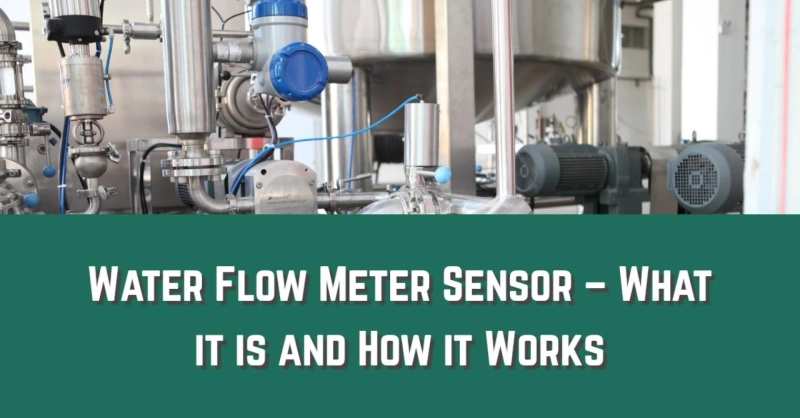To make the right choice when selecting a water flow meter to use in your plant or water flow system, you need to understand first how to operate it. And since there are many types of flow meters, you also need to match or with the right application.
This post will give you all the details of what flow meters are, how they operate, and the various types of flow meters or sensors. Read along for more insights.
A water flow meter/sensor is commonly used in various industries that utilize fluids or gases in their processes or as finished products. A flow sensor is used to monitor or measure the flow rate of gases and liquids such as water linearly and nonlinearly. In addition, the instrument can provide flow rate measurement in terms of mass or volume.
Several mistakes are made when purchasing a flow meter. One of them is going for a less expensive flow meter that doesn\'t function properly, trying to save money. Such a decision will cost you eventually. Besides that, the readings from such meters will not be accurate, and you will end up making losses. Inappropriate flow sensors also cost a lot when installing them. Many plant managers either do this out of ignorance or arrogance. That is why it\'s very important to understand what different flow sensor types are and how they work to provide flow rate. First, here are steps that you need to follow when selecting a flow meter.
What to Consider When Selecting a Water Flow Meter Sensor
When looking for the right flow meter, it is good to first determine whether the flow rate will be totalized or continuous. It is also good to establish if the flow rate results are required remotely or locally. Flow rate transmission can also be digital, analog, or sheared; therefore, know this information first before contacting your flow sensor. The required minimum data update frequency should also be known if the transmission is going to be analog.
Once this information is known, the next action to take is to evaluate the fluid\'s flow characteristics and properties. The plant manager should also know the pipe size and type, meant joint to the flow meter.
Fluid Properties and Characteristics of the Flow
The selection proper flow sensor requires knowledge about the fluid properties and flow characteristics. This involves set parameters of pressure drop, specific gravity or density, pressure, temperature, among other characteristics. The plant manager should also consider the safety and toxicity of the media and how the various properties interact or vary.
Temperature & Pressure Ranges
Besides the normal operation values mentioned above, the min and max temperature & pressure values should be laid bare in the water flow sensor selection process. Others factored to consider whether slug flow can develop, whether it always feels the pipe, or whether it can reverse. As stated above, flow sensors come in so many types, which are designed differently and also have varying working principles. It is also good to know whether the type of water flow meter you require needs special safety precautions when carrying out maintenance or cleaning it.
Mass or Volumetric Units
Proper selection of water flow sensors also demands that the knowledge of whether the flow rate readings roll makes more sense when presented in volumetric or mass units. Unless the density or any other aspect of the flow is constant, using volumetric flow meters is not ideal when measuring media that can be compressed. Before measuring the volumetric flow rate of incompressible fluids, air and gas need to be removed since suspended bubbles will cause errors.
Now that you know what a flow sensor is and what to consider when buying it let\'s focus on the various types of flow sensors available in the market.
Water Flow Sensor Types
Variable Area Water Flow Meter
This type of flow sensor is designed with a tapered tube and afloat. It is used to measure various fluids and gases due to its low-pressure drop, simplicity, wide measuring range, and low cost.
Mass Gas Flow Meters
When measuring flow rate, mass flow meters for gaseous substances hardly depend on the media\'s viscosity, density, or pressure. An example of a mass flow sensor is the thermal flow meter. It measures flow rate by utilizing a heated sensing element and thermodynamic heat conduction principle or a differential pressure transducer and temperature sensor. Data logging is essential for these types of flow sensors. Therefore, they are fitted with integral displays and analog outputs.
Ultrasonic Flow Meters
The fact about ultrasonic doppler flow meters is that they don\'t contact the measured media. In this case, they are perfect instruments for measuring and monitoring slurries and dirty fluids. The working principle used in these types of flow meters is the Doppler Effect. The flow rate is acquired by the frequency shift of an ultrasonic signal reflected by gas bubbles or suspended particles in motion.
Turbine Flow Meters
With an accuracy rate of about 0.5% of the reading, the turbine meter is commonly used to monitor and measure clean liquids and viscous liquids. To increase efficiency when using this type of flow meter, a minimum of 10 pipe diameter of straight pipe is necessary on the inlet. These water flow meter types have rotors with several blades mounted at right angles to the flow.
Conclusion
With so many types of flow sensors to pick from, several factors need to be considered. We have already outlined these requirements for you. We have not exhausted all of the factors, and you can inquire while purchasing from the manufacturer. If you are using a water flow meter with moving parts, regular maintenance, cleaning, and calibration must work efficiently.



